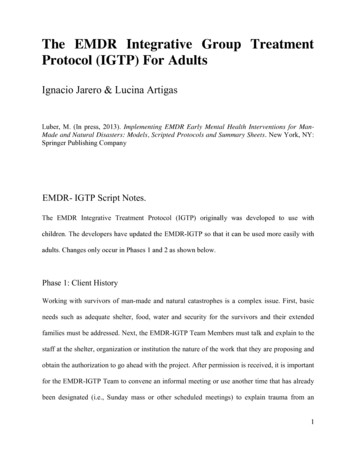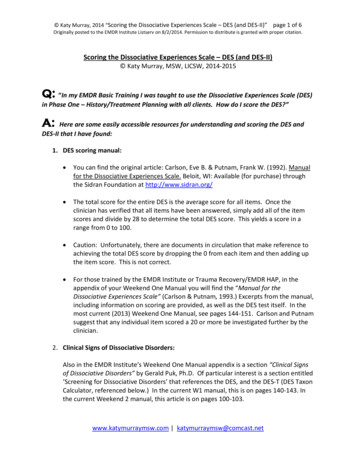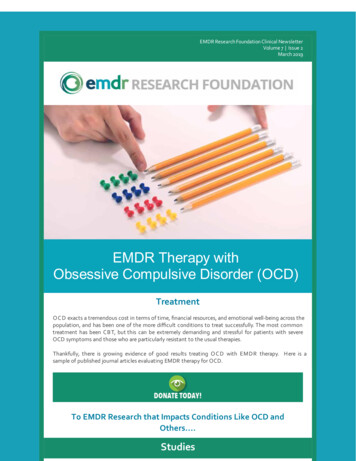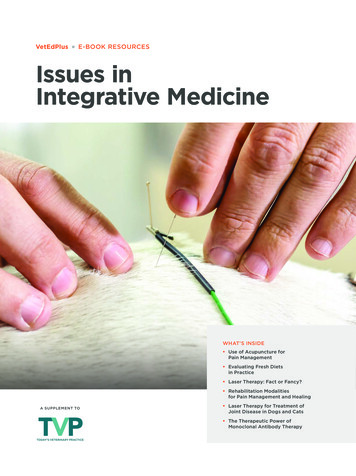
Transcription
The EMDR Integrative Group TreatmentProtocol (IGTP) For AdultsIgnacio Jarero & Lucina ArtigasLuber, M. (In press, 2013). Implementing EMDR Early Mental Health Interventions for ManMade and Natural Disasters: Models, Scripted Protocols and Summary Sheets. New York, NY:Springer Publishing CompanyEMDR- IGTP Script Notes.The EMDR Integrative Treatment Protocol (IGTP) originally was developed to use withchildren. The developers have updated the EMDR-IGTP so that it can be used more easily withadults. Changes only occur in Phases 1 and 2 as shown below.Phase 1: Client HistoryWorking with survivors of man-made and natural catastrophes is a complex issue. First, basicneeds such as adequate shelter, food, water and security for the survivors and their extendedfamilies must be addressed. Next, the EMDR-IGTP Team Members must talk and explain to thestaff at the shelter, organization or institution the nature of the work that they are proposing andobtain the authorization to go ahead with the project. After permission is received, it is importantfor the EMDR-IGTP Team to convene an informal meeting or use another time that has alreadybeen designated (i.e., Sunday mass or other scheduled meetings) to explain trauma from an1
adaptive information processing perspective in as simple language as possible to all the peoplegathered in the shelter, often 100-300. During this big meeting, the EMDR-IGTP Team extendsan invitation to the attendees to participate in a small group process that will help them toreprocess or digest the event. After that, they can inform the attendees of the date, time andlocation of the small group process.It is helpful to know how many people to expect so that appropriate facilities andscheduling can be arranged. If there are not enough team members or facilities for all the peoplewho want to receive support, if possible, schedule several EMDR-IGTP sessions during thefollowing day/s, giving time for the team staff to rest between groups. For a group of 20-30adults, the intervention will take approximately two hours. Also, it is important to take intoconsideration time and facilities for the one to one work team members may do after the EMDRIGTP with the participants who need further help.Say, “We will have our first group work on (state the date) at (state time) in the(state location). Please come up to any of our team members (point to where theteam members are standing) and give them your name and contact information.”Note: It is essential that team members are aware of the needs of the participants concerning theirextended family (e.g., Are the family members safe, missing or did they die?), community (e.g.,Did the participants’ community organizations such as their church, neighborhood, communityassociations, schools, universities survive the catastrophe?), and culture (e.g., Do they need topray before and after the group or individual psycho-emotional work? Is it culturally accepted toexpress emotions in public and/or physical demonstrations of compassion/ affection?).2
The team members ask all these types of questions to the shelter staff, such as the GeneralDirector, Clinical Director, Physicians, etc., prior to the EMDR-IGTP event.Phase 2: Preparation—First Part.The professionals who work with survivors of a traumatic event, especially in the immediateaftermath of trauma, should listen actively and supportively, but not probe for details andemotional responses or push for more information than survivors are comfortable providing.Professionals must tread lightly in the wake of disaster so as not to disrupt natural socialnetworks of healing and support. During this protocol the rest of the team forms an EmotionalProtection Team (EPT) around the adults in order to be aware of their emotional reactions andhelp them when necessary. We recommend a ratio of one team member for eight to ten adults.It is important to keep in mind all of the cautions and suggestions in the EMDR IGTP forChildren.If you have a small group of adults (up to 10), prepare the work area by placing enoughchairs in a circle for both the survivors and the Emotional Protection Team (EPT). If you have alarger number, participants do not need to be seated in a circle; they can be seated like in aclassroom, if this is more comfortable. Welcome the participants and establish rapport with themas they enter the room. Also, it is important to have enough Kleenex.3
The Team Leader introduces him/herself and the members of the EPT:Say, “Hi, my name is (state name). I want to introduce you to our Emotional ProtectionTeam. This is (state name) and this is (state name and introduce as many membersas there are in the EPT). We are here to help you with the emotional aspects of (statethe name of the incident). Thank you for giving us this opportunity to serve you.”Ask that electronic devices be silenced:Say, “We would appreciate if you would take this opportunity to turn off any electronic devicesthat you are carrying or put them on vibrate so that we can support the safety in our grouptoday. (Pause) Thank you.”As in any group, there are basic rules to follow:Say, “In our group today, we would like to set up some ways to help our group process todaysupport your healing. With this in mind, we would like you all to agree to not talk about theexperience that the other participants speak about to people outside this room.We ask that you do not take notes, record or film the group. This is for your benefit only.We ask that you use this time for your own healing rather than a time to express reproach orassign guilt to other people, as this is not an investigation or a time to criticize yours or anyone’sperformance.This is not psychotherapy or a substitute for treatment. This type of work will be available if youor the EPT thinks it would be helpful. Your spoken participation is up to you.There will be a break at the end of the group process. However, if you need to use the restroom,please do so and return as soon as you can. ”4
When there is a group of up to 20 participants, ask them to introduce themselvesindividually:Say, We would like to invite each one of you to introduce yourselves briefly. Please tell us yourname, where you are from, and what happened. Let’s start here (point to participant or sayname if it is known) and then continue around the circle to the right).When it is a group of 20 or above, asking each person will take too long resulting inparticipants becoming bored and leaving, or the next group will have to leave. It is helpful towait for spontaneous responses; not all participants need to speak.If you are working with a big group, say, “We would like to invite you to introduce yourselves.Please tell us your name, where you are from, and what happened?If culturally appropriate, ask for a volunteer to lead the group in prayer:Say, “I would like to ask who would like to volunteer to lead us in prayer?” (Pause).Thank you (state name of volunteer,) please go ahead.”Introduce the Adaptive Information Processing System (AIP) and ask for the types ofsymptoms that the participants have. This part is for screening or triage that may later lead to oneon one intervention, as needed. It is important not to force anyone to talk.5
Say, “Thank you, (state name). Now, I would like to explain to you the basis upon which wehave built our experience for today, We call it the Adaptive Information Processing (AIP) systemand it helps us to digest what has happened to us in the same way we can digest a light meal withno problem, but we often have difficulty when we eat heavy food that is hard to digest.Frequently, we can have a number of symptoms when that happens. What do you notice whenyou have eaten a meal that is too heavy or too much for you?” (Wait for responses).Say, “That is right. In the same manner, heavy information such as (state the nature of thecritical incident) is difficult for the brain to digest and causes symptoms. What symptoms haveyou noticed since the day of the event until now?”Note: Pay attention to the symptoms of deterioration or dysfunction (such as participants who areunable to tend to their basic responsibilities and/or perform daily activities) because they willplay an important role in triaging/selecting who will be invited to receive personal attention atthe conclusion of the EMDR-IGTPWhen everyone has finished speaking the leader, or a co-leader selected beforehand,normalize symptoms by saying the following:Say, “The symptoms that you all mentioned are normal. They are the kinds of reactions normalpeople have after an abnormal experience such as (state the critical incident).Note: If 30 days have already gone by since the critical incident occurred, we do not say that thesymptoms are normal (since they are not), but rather we say:6
Say, “All of the symptoms that you have mentioned are ways your brain’s processing system istrying to assimilate this experience.”Mention the availability of staff for further help.Say, “I also want to remind you that all of us will be available to you after our experience todayand at other times. We would be honored to continue to help you –and others you know- in anyway that we can.”Teach Self-Soothing Exercises.Say, “Our next exercise is one that will help all of us learn to soothe ourselves. During theexercise the Emotional Protection Team will take care of everything, so you are welcome torelax and close your eyes if you would like to do so.”Self-Soothing ExercisesLet one of the EPT lead the following exercises:Abdominal BreathingSay, “Close your eyes put one hand on your stomach and imagine that you have a balloon insideyour stomach. Now, inhale and see how the balloon grows and moves your hand up. Now youcan exhale and see how the balloon deflates, and, your hand goes down. Put all your attention inthat. If anything distracts you gently return to the exercise.”Do this exercise for 5 minutes.7
Concentration Exercise (5 minutes)Say, “I would like you to take a little time to think about your breathing. Notice when you areinhaling and say to yourself, ‘I am inhaling,’ and then notice when you are exhaling and say toyourself, ‘I am exhaling.’ Continue to allow your attention to focus on your breath, for a whilelonger, gently bringing yourself back –if you are distracted- to the inhaling and exhaling of yourbreath.”Do this exercise for 5 minutes.Pleasant MemorySay, “Remember a time when you were calm or happy. (Pause). Now, put your hand on yourchest and let those good feelings and positive physical sensations expand throughout your body.Good. Continue to allow your attention to focus on these good feelings and sensations for awhile longer, gently bringing yourself back –if you are distracted- to the happy and calm feelingsyou are feeling.”At the end, say, “As you open your eyes, remember that in the future all you have to do to bringback the memory is to place your hand over the center of your chest.”Do this exercise for 5 minutes.Butterfly HugSay, “Would you like to learn an exercise that will help you to feel better?”8
Say, “Please watch me and do what I am doing. Cross your arms over your chest, so that the tipof the middle finger from each hand is placed below the clavicle or the collarbone and the otherfingers and hands cover the area that is located under the connection between the collarboneand the shoulder and the collarbone and sternum or breastbone. Hands and fingers must be asvertical as possible so that the fingers point toward the neck and not toward the arms. Nowinterlock your thumbs to form the butterfly’s body and the extension of your other fingersoutward will form the butterfly’s wings. Your eyes can be closed, or partially closed, lookingtoward the tip of your nose. Next, you alternate the movement of your hands, like the flappingwings of a butterfly. Let your hands move freely. You can breathe slowly and deeply (abdominalbreathing), while you observe what is going through your mind and body such as thoughts,images, sounds, odors, feelings, and physical sensation without changing, pushing your thoughtsaway, or judging. You can pretend as though what you are observing is like clouds passing by.”It is important to observe the participants to make sure that they are able to follow along withyou. If not, members of the EPT can be alert and quietly go up to a participant to help as neededand then return to teaching the Butterfly Hug.At the end, say: “In the future, if you experience an on-going, highly distressing stressor (SUD 6 or more) and your self-soothing techniques fail to help you to calm down quickly, do theButterfly Hug to help process the current situation.”9
The Team Leader asks participants how they are feeling:Say, “We have just practiced different ways to soothe ourselves and I am wondering how you arefeeling now?”The Team Leader explains coping strategies:Say, “After a traumatic event such as the (state event) that all of you have been through, itis helpful to make sure that you do some things that may seem pretty basic but are reallyimportant such as drinking a lot of water even when you are not thirsty; eating healthy foods,making sure to exercise (but not overdoing it), and taking short breaks during the day in order topractice your self-soothing techniques such as abdominal breathing, the concentration exercise,or the pleasant memory technique.”Say, “Do any of you have any questions that you would like to ask me or the members of theEmotional Protection Team?”Trauma WorkSay, “Please raise your hand if you have been having trouble sleeping, are scared, if you feelsad, if you still have nightmares, if you feel angry, or if you often think about and remember thenatural or human-provoked disaster that you have suffered.”10
The therapist goes on to say, “It is normal for you to feel this way; you are people who havesuffered an abnormal experience, and that is why it is normal for you to have these feelings. It isalso normal to have different feelings than your friends and other people since each personexperiences and feels things differently. This is really normal.”The aim is to validate the signs and symptoms of posttraumatic stress.The therapist goes on and says, “When you return home after this exercise, you can talk to thepeople you trust about your thoughts and feelings, as much as you want and when you feel mostcomfortable doing so.”The aim is to verbalize the traumatic memories and to respond to the acute need that arises inmany survivors to share their experience, while at the same time respecting their naturalinclination with regard to how much, when, and to whom they talk.At the end of this first part of the Preparation Phase, the team administers the appropriatemeasures (e.g. Impact of Event Scale (IES), Impact of Event Scale-Revised (IES-R) or any othervalid measure).Say, “Here is a scale for you to look at. Please answer the questions on it. If you have anyquestions, please ask one of the Emotional Protection Team Members to help you out.”11
Note: Standardized psychological assessment is used cautiously. It is helpful for team membersto be concerned about the rapport with the participants. They need to demonstrate by theirbehavior that they are truly interested in them as human beings and not as objects of scientificcuriosity. This custom weakens the scientific value of data gathered, while it respects the wishesof our Latin American clients not to be stigmatized by formal testing procedures. In ourexperience, clients also tend to reject assistance from those they judge to be opportunists, in thiscase anyone who seems interested in the victim as an object of study.Phase 2: Preparation—Second Part.It is important to use language that the participants can understand. In countries where culturaldevelopment is not as advanced, it may be helpful to utilize the language that is used withchildren, adolescents, etc. in order to assist participants with the task.Show the participants the faces that measure SUDS from 0 to 10, with 0 being no disturbance,and 10 being maximum disturbance. If you do not have the original faces you can draw them onthe blackboard.Say, “Here are faces that measure our feelings on a 0 to 10 scale, where 0 does not bother youat all and 10 bothers you the most possible.”Note: Clinicians are welcome to use the best words and pictures possible for their population.Familiarize the participants with the scale.Say, “How do you feel when you do a good job? Please point to the face that describes howyou feel.”12
Now say, “How do you feel when you are sick? Please point to the face that tells us how youfeel.”We have observed that participants who are not yet familiar with the numbers will sometimessay a number and point to a face that does not correspond. Thus, it is better to pick the face theypoint to over the number they say (one of the members of the EPT can write the correct number).The members of the EPT hand out white pieces of paper and crayons to each of the participants(have extra crayons in case the participants ask for more).Say, “Please write your name and age on the top left side of the paper (show how to do it).”EPT members can aid those who cannot do it.Say, “Now, please divide the other side of the paper in four equal parts like this. Draw a cross atthe center like this and write a small letter at the top left corner of each section like this.”The therapist shows them how to do it on the blackboard and the EPT helps.Note: Often, we had to divide the sheet of paper in four, given the scarcity of the materials in theshelters, but it is acceptable to use four sheets of paper, making sure that each has the name andthe age of the participant and the corresponding letter, so that the sequence can be identified.Phase 3: Assessment.The therapist says, “Whoever remembers what happened during the event (mentionthe event—hurricane, flooding, explosion, etc.), please raise your hands.”The participants raise their hands.13
Say, “Now, close your eyes and observe what makes you the most frightened, sad, or angryabout that event (mention the event) NOW.”The therapist continues, “Take whatever emerges from your head to your neck, to your arms, toyour hands and fingers, to the crayon, and now open your eyes and draw it in square A.”When all the participants are finished, show them the faces again.Say, “Here are the faces again. In square A, please write the number of the face thatcorresponds to the feeling you get when looking at your drawing (SUDS).”Note: The participants may write spontaneously what they are feeling: “I am afraid,” “I am indanger,” “I can die” Negative Cognition. It is not necessary to ask the participants for it. Justaccept what they do in their drawing. The emotional impact doesn't always appear in the firstdrawing; sometimes it will appear in the second or third one.Phase 4: DesensitizationOnce all of the participants have done this, say the following:Say, “Please put your crayons aside and do the Butterfly Hug while you are looking at yourdrawing.”This lasts for approximately 60 seconds.Next, the therapist says, “Now, observe how you feel and draw whatever you want in square Brelated to the event.”14
When they finish drawing in B, the participants are shown the faces again.Say, “Please look at the faces again and write down the number of the face that corresponds tohow you feel when you look at your drawing in square B.”After writing down the number, say the following:Say, “Please put your crayons down and look at your drawing. While you are looking at yourdrawing, please do the Butterfly Hug.”This lasts for about 60 seconds.Next, the therapist says, “Now, observe how you feel and draw whatever you want in square Crelated to the event.”When they finish drawing C, the participants are shown the faces again.Say, “Please look at the faces again and write down the number of the face that corresponds tohow you feel when you look at your drawing in square C.”After writing down the number, say the following:Say, “Please put your crayons down and look at your drawing. While you are looking at yourdrawing, please do the Butterfly Hug.”Next, the therapist says, “Now, observe how you feel and draw whatever you want in square Drelated to the event.”15
When they finish drawing in D, the participants are shown the faces again.Say, “Please look at the faces again and write down the number of the face that corresponds tohow you feel when you look at your drawing in square D.”After writing down the number, say the following:Say, “Please put your crayons down and look at your drawing. While you are looking at yourdrawing, please do the Butterfly Hug.”Next, the therapist says, “Look carefully at the drawing that disturbs you the most. On the backof your paper, where you wrote your name and age, write the number that goes with the face(SUDS) that best describes how you feel about your drawing NOW. Write that number on theupper right hand corner of the paper.”Phase 5: Future Vision (Instead of Installation)Phase 5 (Installation) of the Standard EMDR Protocol cannot be conducted in large groups forthe following reasons: each participant may have a different SUD level because someparticipants can't go any further; blocking beliefs; previous problems and trauma; or havedifferent timing for processing (for some it cannot be enough to follow the four designs format)and reach an ecological level of disturbance.We can do the Installation Phase during the individual follow-up intervention (see Phase 8).At this stage of the protocol, we work on a Future Vision to identify adaptive or non-adaptivedrawings and cognitions that are helpful in the evaluation of the participant at the end of theprotocol. An example of a non-adaptive Future Vision in an adult is if he does not see a future16
for himself as when a 28-year old man drew a black circle and wrote “I have nothing to do in thefuture.”Say, “Now draw how you see yourself in the future.”Then say, “Write a word, phrase, or a sentence that explains what you drew.”Then say, “Look at your drawing and what you wrote about it and do the Butterfly Hug.”We believe that if participants have an adaptive cognition, the Butterfly Hug will help in theirinstallation and if the participant does not have an adaptive cognition, the Butterfly Hug will helpin the processing to an adaptive state. The EPT monitors this and then gathers all the drawings.Phase 6: Body ScanThe team leader teaches the participants the Body Scan Technique. The therapist says somethinglike the following:Say, “Remember the event. Now, close your eyes and scan your body from your head to yourfeet. If you feel any disturbing or pleasant body sensations do the Butterfly Hug and report it tothe person who is helping you (EPT).”EPT members identify participants with disturbing body sensations and use that informationduring the Phase 8.At the end of this exercise the leader says, “Now move your body like this (the therapistmoves all of his/her body like a dog shaking water off after a bath, making the participantslaugh).”This is a fun, play exercise to end on a positive, playful note.17
Phase 7: ClosureThe therapist then says, “Go to your Safe Place using the Butterfly Hug.”Do this for about 60 seconds.Then say, “Breathe deeply three times and open your eyes.”Phase 8: Reevaluation and Follow-UpAt the end of the group intervention, the EPT identifies participants needing further assistance.These participants will need to be thoroughly evaluated to identify the nature and extent of theirsymptoms, and any co- or preexisting mental health problems. Staff can make this determinationby taking into consideration reports made by the participants’ relatives and/or friends, whatevervalid measure used (i.e. IES, IES-R), the entire sequence of pictures, the SUD Scale ratings,Body Scan, the Future Vision drawing and cognition, and the Emotional Protection TeamReport.The team can treat those who require individual follow-up attention, using the EMDR-IGTPin smaller groups than they were in or on an individual basis, keeping in mind the TargetingSequence Plan and the 3-Pronged Protocol.18
networks of healing and support. During this protocol the rest of the team forms an Emotional Protection Team (EPT) around the adults in order to be aware of their emotional reactions and help them when necessary. We recommend a ratio of one team member for eight to ten adults.










